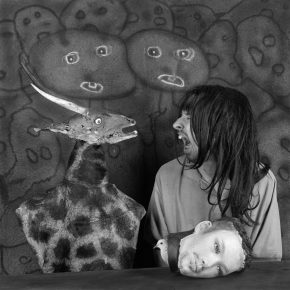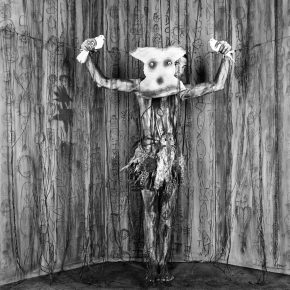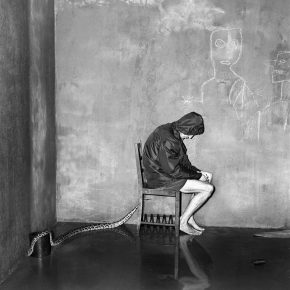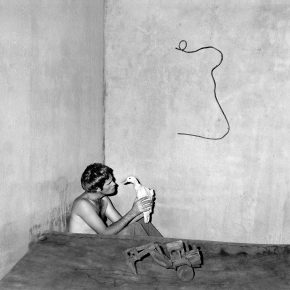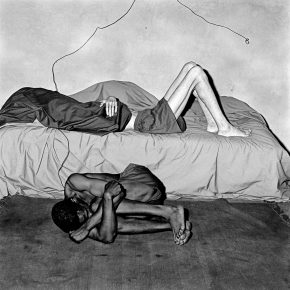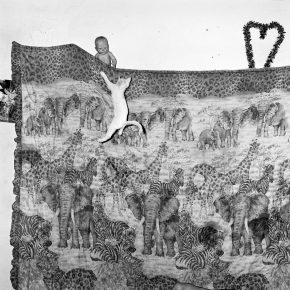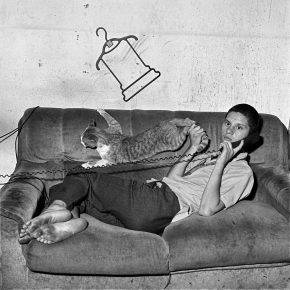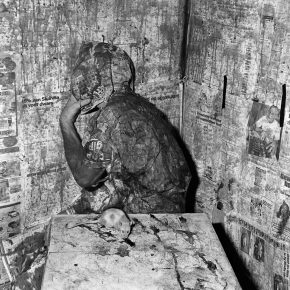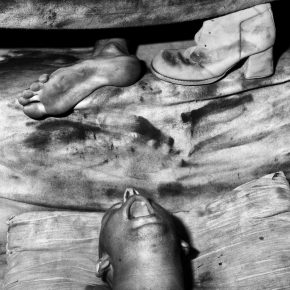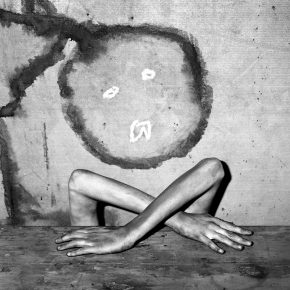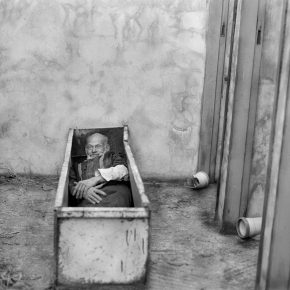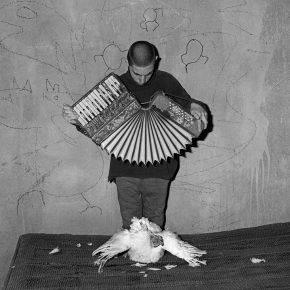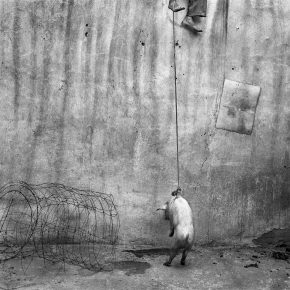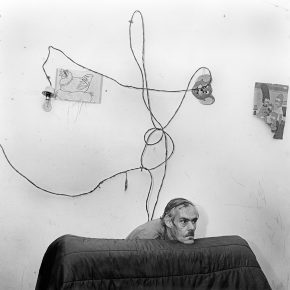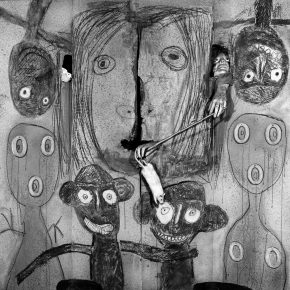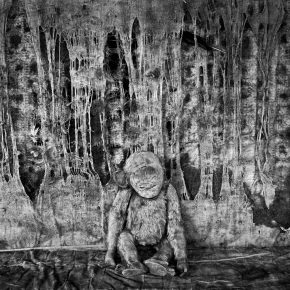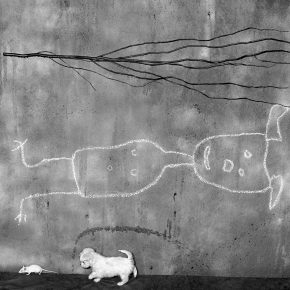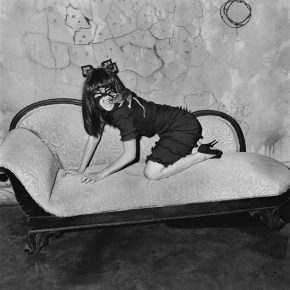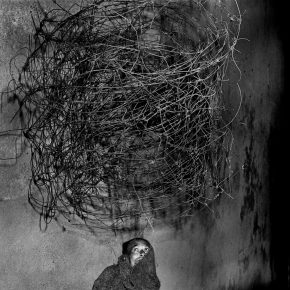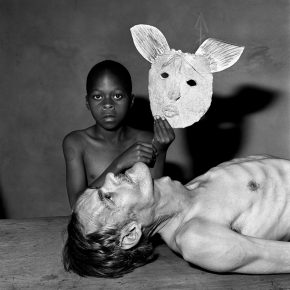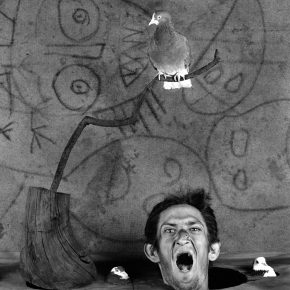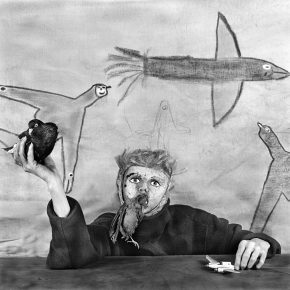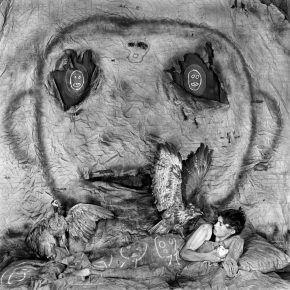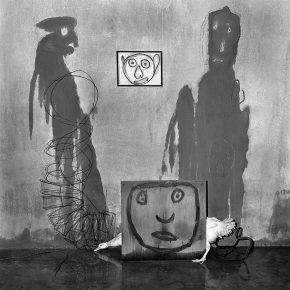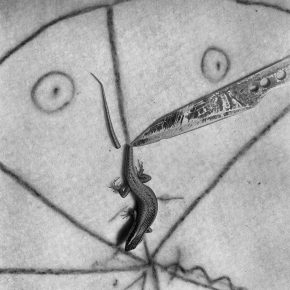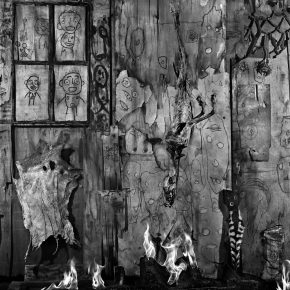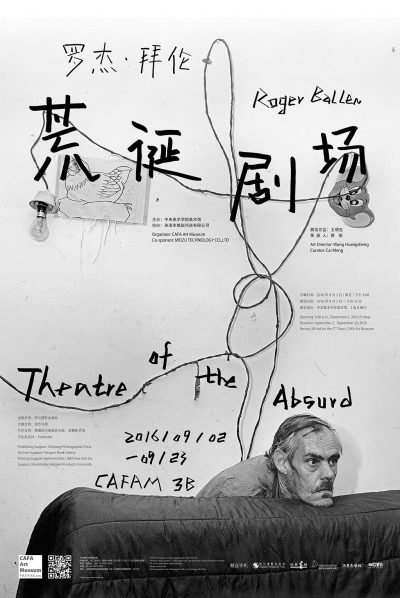
Preface to Roger Ballen: Theater of the Absurd
By Wang Huangsheng
Director, The Art Museum of The Central Academy of Fine Art
To truly know and research an artist/photographer with major international influence requires an in-depth process of layered augmentation and development. When I first saw Roger Ballen’s photographs in a catalogue, I was deeply shocked by the peculiar, absurd, dramatic spectacle. However, this sense of shock didn’t just stem from the strange characters and bizarre scenes of his photographs, but it came more from the black-and-white textural, but somehow indescribably significant tone; the uniqueness of the compositional structure and visual relationship, that sort of blurred mood and fantastical sense of spirit. So I persisted with further examination: ultimately what sort of motivation, life experience, ideology and reality cause Roger Ballen to express himself in this way, using this means of expression to develop such depth in his work? He is a South African artist, with experience as a geographic prospector, he travelled to nearly every corner of South Africa and, just like a “geologist”, he performed excavation and investigation of layer after layer of this territory’s stratum. He trained his acute and unusual photographic perspective to show the mindset, lifestyle, and state of survival of the bottom rung of South African society during a particular period. With sincerity, he captured how completely anxious, dazed, helpless, and absurd their psychology and behavior was, thus constructing a Roger Ballen style of photographic tableau. Instead of tableau, it would be better to say “theater”—a huge performance much greater than South Africa which points out the preposterous “theater” that is the spirit, behavior, reality, and situation of humankind. Consequently, Roger Ballen goes a step further, using static and two-dimensional photographic frames to compose a spatial installation “theater” which is capable of making people enter its midst and subconsciously play the part of a “Roger Ballen style” character. In this “theater”, we have the possibility of being not merely visitors or actors, but rather having a unique spiritual experience and artistic journey to reflect upon life.
Thanks to Roger Ballen for bringing us this artistic feast of visual contemplation and spiritual experience! The Art Museum of the Central Academy of Fine Art is also very fortunate to be able to collect a group of his photographs—our sincerest thanks to Mr. Ballen.
I’d like to thank those organizations and individuals who provided support through funding, publishing, archival access, exhibition and graphic design, exhibition coordination and installation, public education, marketing and promotion. I’d also like to thank the curator for this exhibition, Cai Meng. ??It was only through everyone’s shared, dedicated efforts that we are able to bring Roger Ballen’s Theater of the Absurd?to China to be shown at the CAFA Art Museum. Thank you all!
August 3, 2016,
CAFA Art Museum
Trans. Jillian Schultz
Roger Ballen’s Theater of the Absurd
By Didi Bozzini?
Philosopher, professor, writer, and independent curator
Over the span of forty-odd years, the work of Roger Ballen has travelled a complex path of evolution, both artistic and existential. His black-and-white photographs are characterized by what could unquestionably be called an aesthetic canon: an immediately recognizable one, combining absolute formal precision with harsh, disquieting, bizarre, fanciful, even visionary subjects. These photographs grow out of a multilayered and extremely original creative process, whose exploration of the psyche, and the images that inhabit it, ranges through the realms of autobiography, the natural world, and the habitat of man.
Seen as a whole, his work presents a myriad of facets?polished by skillful hands. ?Memories, reflections, anthropological observations, dreamlike visions, and poetic illuminations are overlaid and compacted into an oeuvre of intense and touching humanity.
The essay that follows certainly does not presume to fathom, let alone explain its secrets. It is simply a series of impressions, notes and comments regarding and running parallel to two fundamental aspects of this vast body of work: the sentiment of the absurd that pervades it, and the theatrical dimension in which it moves.
Why
Every existing thing is born without reason, prolongs itself out of weakness and dies by chance.
Jean Paul Sartre, La Nausée ??
- Always the same damn question: “Why?”
Why do you exist? Why do you think? Why do you do things? Why do you talk about them?
The bottomless hunger for meaning digs into consciousness like a woodworm into seasoned lumber, feeding on lives, facts, acts, our being and our being here. But it is a question that is never appeased, springing up anew after each attempt to put it to rest with an answer.
Thought curves in upon itself in an infinite regress, in search of a beginning, a motivation, and with it, the meaning of whatever existence it is able to envision. It explains, justifies, classifies, finds causes, deduces effects, establishes hierarchies, sequences, systems. In a desperate effort to organize the World according to logic, in linear fashion, to at least momentarily indulge the geometric demands of rationality. Until Death bursts in, unimaginable by definition, a bomb blast that razes the structure of each life, putting an end to this Sisyphean torment and confirming its utter vanity, annihilating all certainties and revealing that the original chaos is the sole, true, concrete reality.
And so, faced with the inviolable boundary of death, wracked by a sense of impermanence and fundamental impotence, the mind engenders the concept of the absurd.
“There’s no reason why” becomes the only plausible answer.
Everything starts and ends without a reason, is done and undone without a reason. Without a reason we are born, live, and die. There’s no reason, so there’s no compass of meaning, no direction. All paths amount to the same. There is no such thing as fate, there is only freedom. All values amount to the same. Every choice is always possible, nothing is fair or foul, good or evil, the absurd is neither horrible nor tragic. The absurd, quite simply, is the impenetrable senselessness of Everything.
Confusion and loneliness are its embodiment in our lives. It is hard to find your own place, when there is no order to things. ?It is hard to explain it to others, when there is no reason why.
- “Confusion is a crucial metaphor for the human condition.” writes Roger Ballen. But his photographs, in their silence, say much more than his words.
Even in his early works, people, animals and objects appear like manifestations of a deep-rooted doubt, a basic uncertainty, an inextricable chaos, which the camera freezes into vivid black and white. Snapshots of a magmatic, paradoxical universe, where every element is meticulously connected to the others, but only according to the alogical laws of chance.
A young man (Eugene on the phone) makes a telephone call, turning vacuous eyes towards the lens, while gripping the tail of a cat that is trying with all its might to escape. An old man ... is shown covering his ears with two tubes that are extensions of his arms. Two men ... are naked in the corner of a room, the seated one blank-faced, the other content to frame his own grimace with a piece of scrap metal.
These are images that erode the very foundations on which the highly rational question of meaning would like to rest. Indeed, revealing its deeper nature, reality presents itself here as an inexplicable hypothesis, one of infinite possible hypotheses. And so the vision imperceptibly slips into the realm of the bizarre, like a waking dream.
True and yet uncertain.
- Even the faces seem to be constantly asking the photographer who depicts them to confirm that they actually exist. Their expressions are quizzical, often incongruous, sometimes excessive, never feigned, always ambiguous.
They are part of a world that does not hold to any logical framework. Narrative, and its rigid links of cause and effect, has given way to a quicksand of emotion in which the characters struggle, free to act and unable to escape. Alone, adrift like castaways on a sea of doubt, trapped in their mode of being by the eyes of others, or, as Sartre wrote, “not characters, but freedoms, trapped in a gratuitous situation that reveals the basic absurdity of their condition” .
- The isolation of these subjects and the gratuitous nature of their actions, are juxtaposed with the deeply inward orientation of the gaze that captures their psychic cores.
Roger Ballen photographs people, things, and animals, but what we see in the end are figures from his mind. Images that have floated to the surface from a murky realm of consciousness. Where catharsis is at the very least unlikely, because the reflection of ourselves that we find submerged there is anything but comforting. Like lanterns in the dark tunnels of a mine, his photographs lead us to the hidden zone where we too have buried the idea of our death, and their harsh light reveals the sense of life’s pointlessness that it inevitably engenders.
“Death is the most important thing in life,” writes Ballen elsewhere. Indeed, the symbols of death multiply and become omnipresent ?as his work moves forward. His pictures increasingly teem with animal carcasses, abandoned objects, portraits of those absent, to the point that they push out the living models, the real person gradually disappearing. This process continues up to his most recent pictures, where the absence becomes so visible as to leave no room for the image of life except a fossil imprint imprisoned in the brittle rock of memory. It is a journey into the self, a diary of inner travel through the kingdoms of malaise and angst, spurred by the sole desire to see and record what is there, definitively unshackled from any hope of explaining it.
- “Why?”–?When the only certainty is the ending, it is absurd to ask, absurd to answer.
What
Estragon : We always find something, eh Didi, to give us the impression we exist ? Vladimir : Yes, yes, we are magicians.?
Samuel Beckett, Waiting for Godot
- A theater is etymologically a place where we watch and are amazed. In this sense, every photograph is in itself a theater. Choosing to look at the world through a camera therefore means accepting and declaring its theatrical nature from the first click of the shutter.
And yet, popular wisdom would have it that the theater is the sphere of fiction and the world is the sphere of reality, just as photography is firmly believed to be a faithful reproduction and painting, on the other hand, a fanciful one. Actors are said to play roles, whereas people incarnate true identities. A painted face is thought to be just an artist’s vision, whereas a photographic portrait is irrefutable proof of its existence. These are the comforting certainties in which our eyes usually confide. ?But what if they proved groundless? ?What if there were more truth in the actions of a character than in the behavior of a living person or more reality in the motionless time of a photo than in the unstoppable instant of a gaze? And to go even further, what if there were more acuity in the imagination of a painter than in the objectivity of a photographer?
- All of Roger Ballen’s work moves within the ambiguous space of these questions, and each of his photographs is the objective portrayal of a situation, the theatrical enactment of how it is experienced, and the pictorial visualization of its appearance, all at the same time. Each of them radically disrupts the lazy habits of our everyday gaze. Like the sleight-of-hand of a magician, who truly makes appear what we only think we see, and makes virtually disappear what we are really seeing, or hides what we expect and reveals what we don’t, blurring together perception and mirage, sign and design, face and mask, shadow and figure.
And this visual dramaturgy in no way reflects an exterior purely formal desire, a stylistic whim, but rather is the very map of his creative voyage, conceived as a plunge into the depths of consciousness, where life’s double lies, where seeing is synonymous with awe, between introspection and observation, reflection and dream.
- In this theater of the mind, which is a theater of the world, the tragedy and comedy of existence are acted out.
The set is made up of odd and often sordid rooms, sometimes not very realistic, but always perfectly real. If you look closely, they are no different from the decrepit places often found in the aberrant megalopolises of our time, built to house life but grown ever more hostile to it.
The actors do not play characters, they are those characters. Caught on the stage of a photograph, in the truth of their being, but still waiting for a moment of genuine existence. Despite all appearances, they are just like anyone, in any life.
They live in the company of animals, both live and stuffed, which flee from them, endure them, brush up against them, or take on the alternating roles of victims, totems, metaphors, and symbols, in a forced and often antagonistic coexistence. It is a relationship that closely mirrors the incongruities of the schizophrenic rapport that our civilization has with Nature, based on both hysterical veneration and methodical destruction.
Even the link between the people, or characters, is for the most part a symmetrical and inevitable contrast, in which opposites attract, collide, and push each other away, driven by uncontrollable forces, within a cloistral space. Like planets in a solar system locked up inside a box. A circumscribed universe, not unlike the society of men, in which by definition, “hell is other people”.
And so a pudgy, thick-witted child mocks the illness of a gaunt old man (Sickroom), a young black man slides out from under the bed where an aging white man is stretched out face-down (Elias coming out from under John’s bed) or a boy sticks his head into a bottomless trash can from which someone else’s foot emerges on the other side (Scavenging).
These figures often have a twin simulacrum, be it a puppet, doll, shadow, or drawing traced on the wall, in a constant interplay of images echoing between world and mind, presence and representation. And one gets the impression that, between stage and audience, they are always looking for something that will give them the guarantee of a real life, as if the absence of a script to recite by heart were the emptiness around which their whole story revolves.
- The photographic theater of Roger Ballen is a theater of the absurd. What we see on stage reveals just how inadequate any rational, discursive tool is to describing the true human condition. If it is senseless to ask “why”, these photographs show “what”. What is done, what is thought, what is dreamed up, to get the sense that one exists. They are a looking-glass in which the image of a consciousness appears. What one sees is “what”, but the question that the mirror asks is “Who? Who are you?”
Who
Who in the world am I ? Ah, that’s the great puzzle.
?Lewis Carroll, Alice’s Adventures in Wonderland
?- “My purpose in taking photographs over the past forty years has ultimately been about defining myself. It has been fundamentally a psychological and existential journey.” ?This is how Roger Ballen describes his artistic path in a recent interview.In essence, his photographs are steps in an inward odyssey that passes through the world.
This vast theater, a mirror in which everything is blurred together and everyone gets lost, amid vague shadows and sudden gleams of light, things that appear and characters who disappear, marionettes, scenes in trompe l’oeil, masks, costumes and disguises, is one he has explored from the attic to the cellar, lighting his way with the lamp of a single question: “Who am I?” And every image captured by his camera is a piece of the puzzle that could contain the answer.
But once inside the looking-glass, the wonder of discovery has replaced the desire to arrive at the destination, and the nature of the question has changed. It no longer aspires to reach a goal, it no longer asks for an answer, it simply indicates a way. Through an imperceptible shift in viewpoint, “Who?” has become “How?”, opening up a wider path, beyond the idea of a monolithic identity, through its infinite, possible modes.
And so the magic of forms has altered the direction of this path and multiplied its horizons, within the boundless chambers of the mind and the innumerable variables of the gaze. Inside this labyrinth, travel itself has become the traveller’s true goal.
Always searching, without ever giving in to the absurd need to find, because, as Eugene Ionesco wrote: “It’s not the answer that enlightens, but the question.”
November 2013
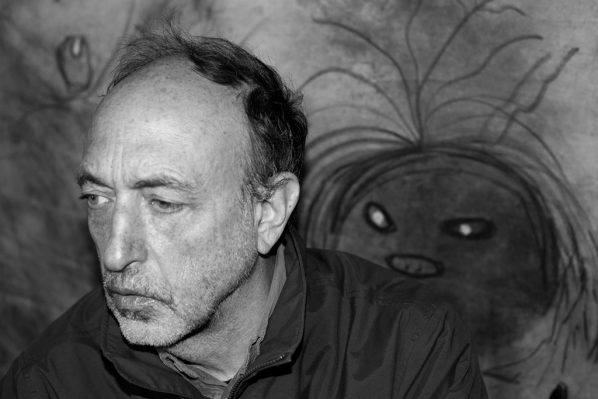
About the artist
As one of the most influential and important photographic artists of the 21st?century, Roger Ballen’s photographs span over 50 years. Ballen is best known for his psychologically powerful and masterfully composed images that exist in a space between painting, drawing, installation and photography.
Roger Ballen was born in New York in 1950, but as lived in Johannesburg, South Africa for the past 35 years. Initially, his work as a Geologist took him into the countryside where he started entering people’s homes photographing in documentary style. After 1994, he no longer looked to the countryside for his subject matter, finding it closer to home in Johannesburg. Over the years his distinctive style of photography has evolved using a square format film camera. Beginning in the mid-nineties his aesthetic began to move into the realms of what he refers to as“documentary fiction.”Ballen’s characters act out an absurd tableau in the series Outland?(2001) and Shadow Chamber?(2005). The line between fantasy and reality in Boarding House?(2009), Asylum of the Birds?(2014) and the later work has become increasing blurred. In his enigmatic sets people are absent or where they do appear it’s as disembodied hands and feet interacting with animals. Ballen has invented a new hybrid aesthetic, revealing the absurdity of the human condition.
Roger Ballen has produced over twenty books and his work is collected by the most important museums in the world. Over the years his work has had increasing influence on Chinese artist and photographers.
About the exhibition
Art Director: Wang Huangsheng
Curator: Cai Meng
Visual Designer: Ji Yujie
Space Designer: Sun Hua
Catalogue Designer: He Hao
Exhibition Installation: Wu Peng, Ma Liang, Min Zhiyi
Public Education: Ren Rui
Press and Communication: Yin Ranxu
Assistant Curator: Egami Etsu
Organizer: CAFA Art Museum
Co-sponsor: MEIZU TECHNOLOGY CO., LTD
Publishing Support: Zhejiang Photographic Press
Archive Support: Paragon Book Gallery
Printing Support: Hahnemühle, UMO Fine Arts Inc.
Support of Exhibition Related Products: Fromcafa
Opening Ceremony: 3:00 p.m., September 2, 2016 (Friday)
Exhibition Dates: September 2 to 23, 2016
Exhibition Venue: 3B Gallery, CAFA Art Museum
Acknowledgement (In no particular order) :
Li Nan\ Hingzer Cheung\ Ng Hon Lam\ Zheng Youyou\ Wang Jiang\ Nick Wang\ Lian Zhiping\ Wei Guangjun\ Enzo Bai\ Guo Tiancong\ Ren Ze\ Liu Huan\ Xu Jiemin\ Yin Dejian\ Tao Wenjie\ Zhao Yingxin\ Yao Lu \ Xue Jiang\ Tony Zhu\ Zhao Yan\ Jillian Schultz\ Ma Buyun\ Sun Peng\ Zhang Mingfang\ Zheng Lijun\ Shi Guang\Meng Qingkai
Courtesy of the artist and CAFA Art Museum, for further information please visit http://museum.cafa.com.cn.


